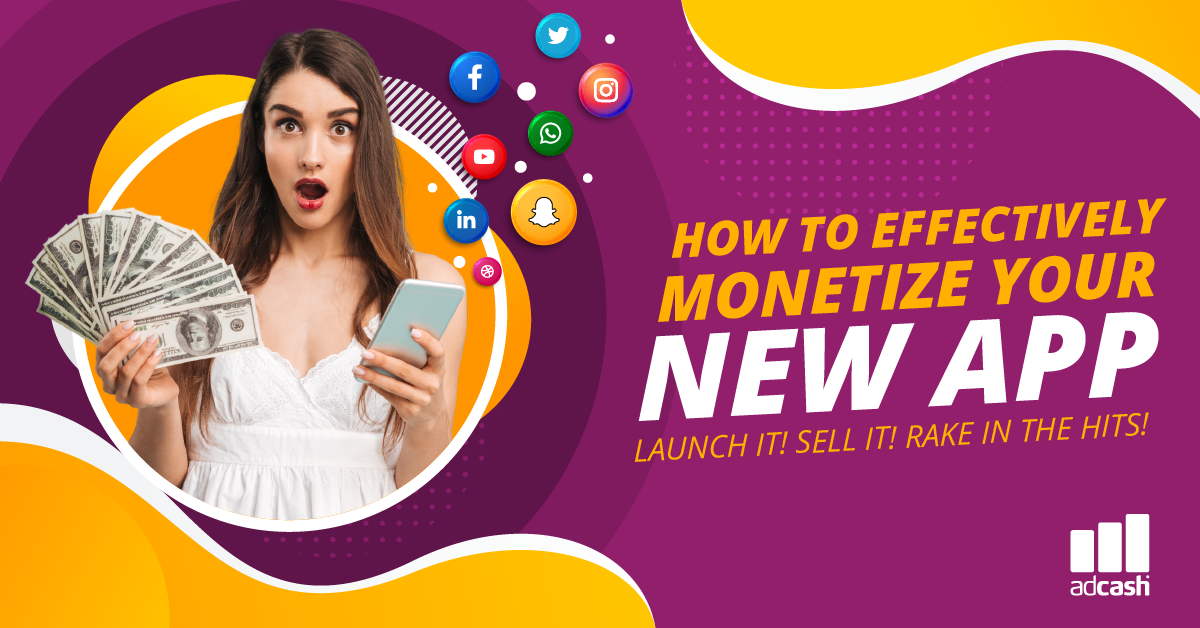Okay, so you’ve put the final touches to the last line of code and… Boom! You’ve got a fresh new app ready to go to market. But here’s the thing…
With over 2.9 million apps currently available in the Google Play Store and a further 4.4 million available for download in the Apple App Store, how do you stand out in an endless sea of apps covering every topic under the sun, from finance and fitness to gaming and ghosts!
Let’s cut through the noise together and figure out some of the best ways to monetize, gain valuable downloads, and spread the word.
Commonly used (and effective) monetization models
The Premium Payment Model
The “pay to play” model carries strong digital marketing psychology. Because of this, the higher the price, the better the perception of quality in the eyes of the end consumer.
So, how does it work? Users will need to pay upfront before downloading the app. In doing so, the app is usually theirs for life. Upgrades will pop up from time to time, but the initial pricing model is unlikely to fall away.
This monetization model comes down to confidence. Therefore, the creators behind the product need to know that the quality, interface, and value add justifies the paywall.
The value proposition needs to be strong enough to persuade the end-user to pay for it and not opt for any free, competing solutions.
Premium apps
The most profitable premium apps sell their app’s value proposition through effective positioning. At the end of the day, the app needs to position itself as a distinct option on the App Store.
A perk to paying a premium price is a clean and well-engineered interface with hardly any in-app advertising Subsequently, this makes the experience ten times better than a host of free solutions, weighed down with ads.
The decreased need to sell ad space also gives developers the time to refine features and improve interfaces.
If you’re on both sides of the advertiser/publisher spectrum, check out these App Install tips.
Some of the pros of the Premium Monetization Method
- Strong monetization for publishers/app marketers when strategically positioned.
- Increased user engagement and brand loyalty (which comes from paying a premium).
- A cleaner interface with less need for in-app advertising.
- Time is set aside to refine and improve the product.
Some of the drawbacks of the Premium Monetization Method
- With so many competing products on the App Store, positioning can be difficult.
- App stores tend to take a heavy cut of the overall revenue.
- The higher cost of the premium will lower the volume of daily/weekly downloads.
Freemium
Here the app is entirely free, however there are features and/or functionality that come at a price to be bought separately.
The freemium case gives the consumer the ability to test out a feature they usually wouldn’t have access to.
The feature is designed to boost the user’s app experience as much as possible and then fall away to feel compelled to purchase the feature at a later stage.
Some of the pros of the Freemium Monetization Method
- There is infinite potential to bring in a larger user base.
- Allowing users to test features encourages engagement and reciprocity.
- The model is highly flexible and can be used in almost any vertical.
- The model can bring multiple revenue streams to the table over a sustained period.
Some of the drawbacks of the Freemium Monetization Method
- There need to be enough unique paywall features to warrant user engagement.
- Too many free features will make it harder to sell the upgrades.
- The free experience needs to be exceptional to encourage users to invest.
Subscriptions
Somewhere in the middle of premium and freemium lies subscriptions and paywalls.
A strong play to garner further exposure for your brand, the basic product is released to the public, therefore any further features lie behind a paywall.
This method is effective on a few different levels. On the one hand, it gives the public a taste of the capabilities and entices them to level up. However, it also gives the development team the time to add new and improved features to the app in their own time.
Paywalls
The user is often given curated (in-app) examples/previews of what content and features lie behind the paywall.
The consumer is directed to a subscription/renewal page, offering them the choice to expand the capabilities of the offer. Developers will push quite hard to get users to sign up for auto-renewals.
Monthly renewals are as good as it gets when it comes to sustaining your bottom line.
Additionally, if the product is popular enough, developers can get users to sign up for a monthly subscription complete with auto-renewals (where the cost will be deducted monthly)
Mobile games and software feature apps do this extremely well.
They give you enough access to the minimum viable product (MVP), hoping that when you level up your workflow/leisure time, you’ll take the 2.0 version.
Top news outlets do the same, where also the number (and quality) of articles depend on what you pay.
Some of the pros of the Subscription/Paywall Method
- Users get a taste of the full app experience before spending any money.
- Auto-renewals have the longest lifespan and continue to generate steady revenue.
- Developers can analyze content for triggers that will get users to pay.
Some of the drawbacks of the Subscription/Paywall Method.
- It can be tricky to decide on the best pricing model.
- This method doesn’t transfer well to all verticals.
- If the content is multi-platform, using the same pricing logic can be tricky.
In-App Purchase
An extension of the freemium model, an eCommerce feature is added to your app. Indeed, this usually entails an in-app booster, bonuses, and/or skins. Certain apps even ship physical items straight to your front door.
These goods blend in with the app’s logic and enhance the user’s overall in-app experience. Therefore, this method is widely used in many verticals, but it’s the mobile gaming sector where in-app purchases truly flourish.
Mobile Gaming
Think of some of today’s most popular mobile games, like “League of Legends” or “Among Us.” It is playable but far more intriguing when additional elements, powers, skins, or armor are unlocked (for an added fee).
This paywall’s effectiveness lies in the frequency of new features being added to the game. With each new feature added, another monetization channel appears. It’s no wonder that games like these hit the $50 million mark and beyond.
For more helpful app hints, check out the 2021 Monetization Guide for Publishers.
Some of the pros of the In-App Purchase Monetization Method
- Virtual goods sell extremely well, and profit margins continue to climb.
- The Gaming and eCommerce sector has mastered this method.
- Once invested in the app, It’s easy to upgrade users from small purchases to larger ones.
Some of the drawbacks of the In-App Purchase Monetization Method
- App stores now require a taking of revenue generated from virtual goods.
- Stronger legal restrictions are in place to prevent accidental purchases.
Sponsorships/placements (incentivized advertising)
One of the least practiced monetization methods is sponsorship and product placement.
This method requires a good partnership between the advertiser and the publisher. It would help if you considered the product-to-app compatibility and the time spent in developing the right capabilities.
In essence, an advertiser who wants to market a particular product or service will reach out to the team behind an app that fits the bill. They’ll make a deal for the product to be brought into the app as a natural part of the user experience.
Think of a fitness app that might offer a sponsored reward when a certain task is completed, or perhaps a shopping app. Once a particular amount has been spent in-app, a free product will be added to their cart to encourage continued brand loyalty.
Open a publisher account today.
Some of the pros of the Sponsorship/Placement Monetization Method
- There is strong potential to collaborate with different advertisers/product owners.
- High engagement potential results in a strong marketing strategy for both.
- When done well, sponsorships can enhance the overall in-app experience.
Some of the drawbacks of the Sponsorships/Placement Monetization Method
- Time and resources are needed to customize the app for every campaign.
- 100% trust between the two parties is essential.
- A revenue-sharing model will need to be tightly negotiated on both sides.
In-App Advertising
In-app advertising is widely used, globally accepted, and the only real way to monetize your app when it’s going onto the market as a free product/service.
The primary goal is to grow your user base and gather as much audience data as possible. This data can be sold to an ad network or other publishers, who may market to your users.
Some of the pros of the In-App Advertising Monetization Method
- Rich data enables detailed targeting for advertisers.
- Ad partners will provide advertisers, and in doing so, allow you to focus on other things.
- People love free products, therefore so your audience will grow quickly.
Some of the drawbacks of the In-App Advertising Monetization Method
- Ads may damage the end-user experience from intrusiveness and/or irrelevance.
- If the app is very niche or your partner’s ad network is too small, demand is hard to find.
- Data sharing restrictions can limit the information available to the publisher.
The Takeaway
Successful publishers never rely on 1 monetization strategy. It’s common for 2 or 3 models to appear at the same time.
While monetizing your app traffic is great, it’s essential to have a quality user experience.
If the user is having difficulty navigating your app, overrun with in-app ads, confusing promos, or unnecessary paywalls, they’ll move to other apps. So, always balance quality UX and steady monetization efforts.
That’s it for now. Tell us if we missed anything in the comments below. Good luck selling your new app, and reach out to us anytime to tailor your app traffic to the tee!
Bye for now.



Join the conversation
0 comments
Submit a comment
Your email address will not be published. Required fields are marked *